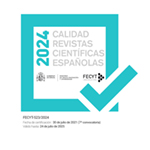Los sonidos del vuelo trascendente
Resumen
Los módulos de afinación prehispánicos de tradición huari, en estrecha relación con el sistema de medición Pichqa-tawa, fueron sin duda producto de una mano de obra especializada aplicada a la construcción de objetos con función sonora que, seguramente, respondió a una demanda en igual orden de especialización, posiblemente ceremonial. En el Horizonte Medio, coincidiendo con la expansión Huari, se observa la aparición de un tema iconográfico con probable impronta cultural sud-costeña, fuertemente asociado con las actividades ceremoniales y los llamados «vuelos extáticos», que tiene por motivo central un personaje, aparentemente de elevado rango, en posición ventral con la cabeza torsionada hacia arriba/atrás, al igual que sus miembros inferiores. Generalmente, en las iconografías Recuay, Chincha y Huari este personaje tañe una flauta característica, como las flautas óseas Huari que analizamos en nuestra investigación.Descargas
Descarga artículo
Licencia
La Revista Española de Antropología Americana, para fomentar el intercambio global del conocimiento, facilita el acceso sin restricciones a sus contenidos desde el momento de su publicación en la presente edición electrónica, y por eso es una revista de acceso abierto. Los originales publicados en esta revista son propiedad de la Universidad Complutense de Madrid y es obligatorio citar su procedencia en cualquier reproducción total o parcial. Todos los contenidos se distribuyen bajo una licencia de uso y distribución Creative Commons Reconocimiento 4.0 (CC BY 4.0). Esta circunstancia ha de hacerse constar expresamente de esta forma cuando sea necesario. Puede consultar la versión informativa y el texto legal de la licencia.









